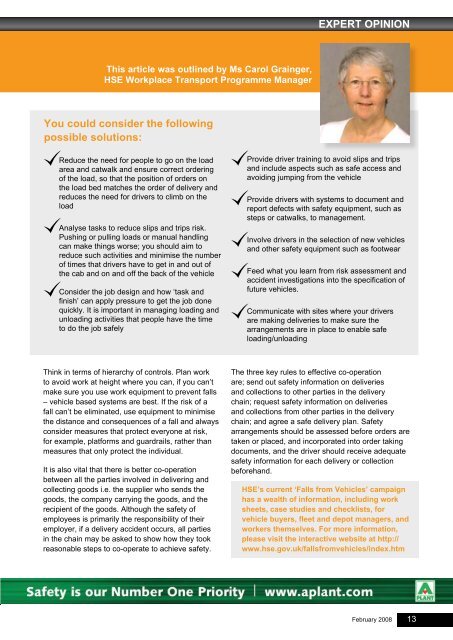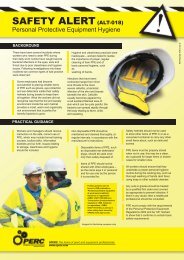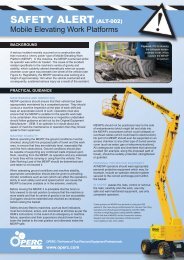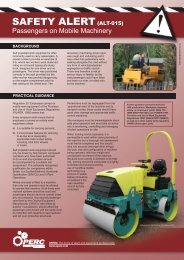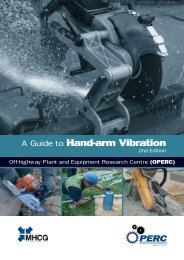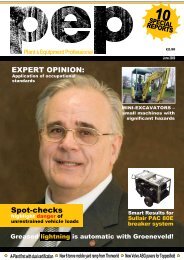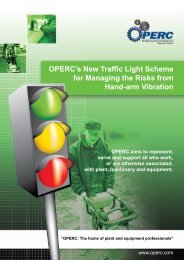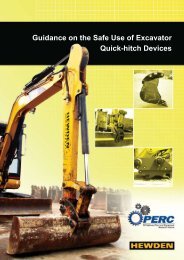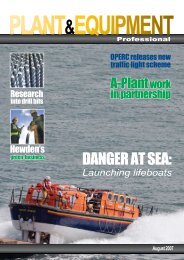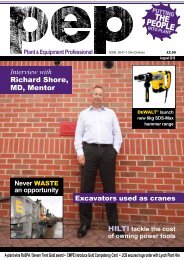Plant&Equipment
Download pdf - OPERC
Download pdf - OPERC
- No tags were found...
Create successful ePaper yourself
Turn your PDF publications into a flip-book with our unique Google optimized e-Paper software.
Expert opinion<br />
This article was outlined by Ms Carol Grainger,<br />
HSE Workplace Transport Programme Manager<br />
You could consider the following<br />
possible solutions:<br />
Reduce the need for people to go on the load<br />
area and catwalk and ensure correct ordering<br />
of the load, so that the position of orders on<br />
the load bed matches the order of delivery and<br />
reduces the need for drivers to climb on the<br />
load<br />
Analyse tasks to reduce slips and trips risk.<br />
Pushing or pulling loads or manual handling<br />
can make things worse; you should aim to<br />
reduce such activities and minimise the number<br />
of times that drivers have to get in and out of<br />
the cab and on and off the back of the vehicle<br />
Consider the job design and how ‘task and<br />
finish’ can apply pressure to get the job done<br />
quickly. It is important in managing loading and<br />
unloading activities that people have the time<br />
to do the job safely<br />
Provide driver training to avoid slips and trips<br />
and include aspects such as safe access and<br />
avoiding jumping from the vehicle<br />
Provide drivers with systems to document and<br />
report defects with safety equipment, such as<br />
steps or catwalks, to management.<br />
Involve drivers in the selection of new vehicles<br />
and other safety equipment such as footwear<br />
Feed what you learn from risk assessment and<br />
accident investigations into the specification of<br />
future vehicles.<br />
Communicate with sites where your drivers<br />
are making deliveries to make sure the<br />
arrangements are in place to enable safe<br />
loading/unloading<br />
Think in terms of hierarchy of controls. Plan work<br />
to avoid work at height where you can, if you can’t<br />
make sure you use work equipment to prevent falls<br />
– vehicle based systems are best. If the risk of a<br />
fall can’t be eliminated, use equipment to minimise<br />
the distance and consequences of a fall and always<br />
consider measures that protect everyone at risk,<br />
for example, platforms and guardrails, rather than<br />
measures that only protect the individual.<br />
It is also vital that there is better co-operation<br />
between all the parties involved in delivering and<br />
collecting goods i.e. the supplier who sends the<br />
goods, the company carrying the goods, and the<br />
recipient of the goods. Although the safety of<br />
employees is primarily the responsibility of their<br />
employer, if a delivery accident occurs, all parties<br />
in the chain may be asked to show how they took<br />
reasonable steps to co-operate to achieve safety.<br />
The three key rules to effective co-operation<br />
are; send out safety information on deliveries<br />
and collections to other parties in the delivery<br />
chain; request safety information on deliveries<br />
and collections from other parties in the delivery<br />
chain; and agree a safe delivery plan. Safety<br />
arrangements should be assessed before orders are<br />
taken or placed, and incorporated into order taking<br />
documents, and the driver should receive adequate<br />
safety information for each delivery or collection<br />
beforehand.<br />
HSE’s current ‘Falls from Vehicles’ campaign<br />
has a wealth of information, including work<br />
sheets, case studies and checklists, for<br />
vehicle buyers, fleet and depot managers, and<br />
workers themselves. For more information,<br />
please visit the interactive website at http://<br />
www.hse.gov.uk/fallsfromvehicles/index.htm<br />
February 2008<br />
13


